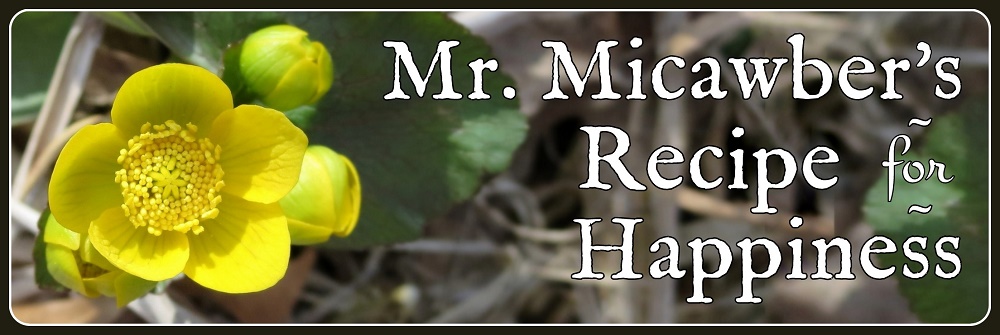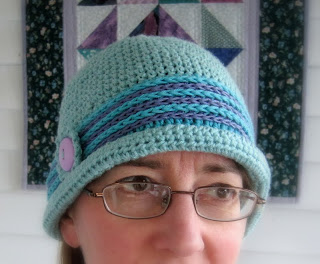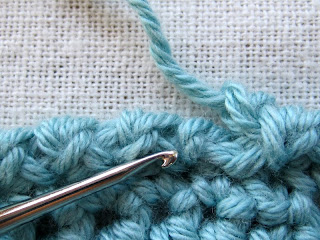"Join with sl st. Cut yarn and weave in ends."
A handy little stitch, the slip stitch - but when used to finish the final round of a motif or project, it can skew the edge just a little bit out of shape.
How does this happen? Well, in the normal course of things, one crochet stitch flows into the next, with nary a break between 'em. The joining slip stitch, however,
inserts a stitch - and, when tied off, a knot - which creates a tiny bump or bulge at the edge of your carefully crocheted motif or hat.
But rounds must be closed. Yarn must be tied off. Is there no way around this pesky slip stitch? Yes, there is! Enter the
Invisible Join (trumpets tooting, crowds cheering and waving hooks, yarn snippets drifting down like confetti).
I'm a big fan of the Invisible Join because it's just that - invisible. It creates the illusion of a seamless edge, and it's very quick and easy to do.
Here are the basics of an Invisible Join:
Note: Invisible Joins can be made using a tapestry needle OR a crochet hook several sizes smaller than your project hook. (I like to use a crochet hook, since it doesn't need threading.)
When you complete the final stitch of your round, cut yarn, leaving a 2" tail:
Gently pull the yarn tail up and out of the stitch:
Insert hook from
back to
front of the stitch you're connecting to (see
Notes below on which stitch to choose):
With hook (or needle), gently pull the yarn tail through.
Now turn your work around so that the reverse is facing you. Insert hook, from
bottom to
top, through the back loop of the final stitch (where the yarn tail came from in the first place). If there is more than one horizontal strand on the back of the stitch, insert hook through at least two of them (see
Tip below for more details):
 |
| Up through the back horizontal strands |
Gently pull the yarn tail down and through. That's it!
Turn your work over and admire the seamless edge. Pretty cool, huh?
Now you can weave in that yarn tail, and no one will ever know which stitch was the last.
Tip: Normally, invisible join instructions tell you to bring the yarn tail down through the top back loop only of the final stitch. This works just fine - but I like to take it a step further. (You've heard of OCD? Obsessive Crochet Disorder? I've got it bad.)
For a stronger join that truly mimics the stitches around it, first think about the final stitch - the one you made right before the invisible join.
When making that final stitch, how many loops did you pull through at the very end of the stitch, after the final yarnover? (For a single, double, or triple crochet it would be 2. For a half double crochet, it would be 3.) So, when finishing the invisible join,
bring the yarn tail down through that same number of strands.
For example: if your final stitch was a double crochet, and you want your invisible join to truly mimic a double crochet, pull the yarn tail down through 2 back strands of your final stitch - because that's how many loops you pulled through to finish the double crochet.
To make the illusion complete, take the yarn tail through at least one vertical bar of the next stitch over. This will eliminate any gaps between your final stitch and your first stitch.
 |
Finally, take yarn tail through at least one
vertical bar of the next stitch over. |
Notes:
Now that you've got the basic technique, let's take it a bit further. To which stitch should you connect an Invisible Join? It's really up to you; but here are some guidelines:
When you want to maintain an exact stitch count, you should:
Connect your Invisible Join to the
second stitch away from your final stitch. (I call this the Formal Invisible Join.) Why skip over a stitch? The Invisible Join may be invisible, but it's still a stitch; if you insert it
between two stitches, it will add 1 to your count. By skipping over a stitch, you maintain the exact number of stitches you started with.
Remember not to pull too tightly on your Invisible Join, especially when skipping over a stitch. You want it to lie right on top of the stitch you're skipping, and match its size.
I used this technique in the
Marigold Hat, Round 20 of the crown:
 |
| Skipping over a stitch (to maintain stitch count) |
When stitch count doesn't matter, as at the final edge of a glove or hat, you can:
Connect your Invisible Join to the
next stitch over - if you want to, and if it looks alright. (It's really a matter of trial and error, and doing what works best for the project in hand.)
This join worked well for my
Wickerwork Mitts:
 |
Connecting to the next stitch over
(where stitch count is not important) |
When your round starts with a cluster, you should:
Chain 1 less than you normally would to start the round/cluster, and when the round is complete, connect your Invisible Join to the top of the cluster (which counts as the second stitch - making this a Formal Invisible Join).
For example, the
Pennies & Lace Block, Round 2:
 |
Connecting to the top of a 2-dc cluster.
(Cluster was started with a ch-2, NOT ch-3.) |
When making circular motifs, you can:
Chain 1 less than you normally would* to get the yarn up to the required height. (I use chain 1 for single crochet and half-double crochet; chain 2 for double crochet.) Counting these chains as the first stitch, make the rest of the stitches called for (for example, if the pattern calls for 12 dcs: start with a chain 2, then make 11 dcs). Connect the Invisible Join to the top of the first "real" stitch, skipping over the top of the beginning chain(s). (Another variation of the Formal Invisible Join.)
*If your chains tend to be very tight and short, then use whatever amount works best for you.
An example of this can be found in the
Pennies & Lace Block center.
 |
Chain 2 + 11 double crochets + 1 invisible join
= 12 stitches! |
The Invisible Join is fast and easy, and can greatly improve the look of your in-the-round crochet. Once you start using it, you'll find that it has all sorts of useful applications.
If you have any questions, feel free to ask using the comment box below.
Thanks for viewing this Visible Post, and happy Invisible Joining!
~ ~ ~ ~ ~ ~ ~ ~ ~ ~ ~ ~



























































